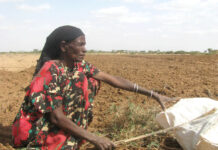
Sydney Kawadza
Zimbabwe could have been a source of a COVID-19 variant that ravaged the country and Southern Africa in December 2020 and early this year, a research paper published by Lancet has revealed.
The paper “Surveillance of SARSCoV-2 in Zimbabwe shows dominance of variants of concern” states that prospective surveillance of SARS-CoV-2 by genome sequencing in Zimbabwe during the period identified that variants with concerning mutations are prevalent in sequenced samples.
December 2020 and January this year have been identified as the period of the so-called “second wave” in Zimbabwe.
Cases of the coronavirus peaked in January with Zimbabwe recording very high daily confirmed cases of the virus going above 1 000 with the cumulative number of confirmed cases increasing by more than 58 percent.
The cases jumped from 13,867 cases including 363 deaths on December 31 last year to 33 271 cases including 1 193 deaths by January 31, 2021.
The research paper states that less than five percent of public SARS-CoV-2 genomes are from low-income and middle-income countries, where 80 percent of the world’s population resides and has been similarly affected by COVID-19.
“The recent, worldwide spread of variants of concern has highlighted the need for global vigilance. In December, 2020, 95 (89 percent) of 107 sequenced cases contained mutations of concern, rising to 102 (95 percent) of 104 in January, 2021.
“The identified variants included the previously reported B.1.351 (501Y.V2) and A.23.1 variants, along with a novel variant under investigation (C.2).
“The B.1.1.7, B.1.525, P.1, and P.2 and variants were not identified in Zimbabwe. Variants with concerning mutations have all replaced previously identified lineages in Zimbabwe.”
In an interview, Mpilo Hospital acting chief executive Professor Solwayo Ngwenya said the 501Y.V2 variant which swept across South Africa found its way into Zimbabwe.
“It shows that the variant that was experienced in December was 501Y.V2 and was also dominant in South Africa accounting for 69 percent of the cases. If you look by January this number had gone up to 95 percent.
“So it means that in Zimbabwe we are having a dominant variant which was very aggressive and different from the original variant. There was a possibility of the C2 that originated from Zimbabwe,” he said.
Professor Ngwenya said this showed that this virus can change anytime if you are giving it time to multiply in the population you can have so many variants.
He said this also indicated that the situation remains dangerous adding that Zimbabwe needs to be very careful and make sure that the country curbs the spread of this coronavirus.
“The moment we are allowing it there will be new, totally different variants from the variants that are known. This will be very deadly and highly transmissible, very infectious and will kill a lot of people.
“The pace of developing vaccines may not keep up with the same pace of the developing variants,” he said.
In the article, it was noted that the B.1.351 variant of concern, originally identified in South Africa, accounted for 74 (69 percent) of 107 sequenced cases in December, 2020, and 99 (95 percent) of 104 sequenced cases in January, 2021.
“The population structure was consistent with multiple separate introductions. Zimbabwe is the second country other than South Africa to report B.1.351 as the dominant variant to date,” it was noted.
The article further notes that as in other countries, this variant has been associated with increased transmissibility, resulting in overwhelmed health-care systems and in higher mortality than the first wave.
“Secondly, the A.23.1 variant of concern, first reported in Uganda, was observed in 3 (three percent) of 107 sequenced cases in December, but was not observed in 104 sequenced cases in January.
“Thirdly, a variant designated C.2 and containing a spike protein mutation (N501T) that was previously reported in another lineage of SARS-CoV-2 found in mink was present in Zimbabwe in both December, 2020, and January, 2021.”
The paper also states that the N501T is thought to improve ACE2 receptor binding in mink.
“A mutation in the same location, N501Y, is associated with increased transmissibility in humans.
“In December, 2020, 18 (15 percent) of 117 of cases were found to be of the C.2 variant, whereas in January, 2021, this number fell to 3 (three percent) of 104.”
Phylogenetic analysis of international genomes of the C.2 variant indicated that they were interspersed with C.2 genomes from Zimbabwean cases, indicating that Zimbabwe was a possible source.
A phylogenetic analysis is the study of the evolutionary development of a species or a group of organisms or a particular characteristic of an organism.
The paper concludes that variants with concerning mutations identified in December, 2020, and January, 2021, have replaced previously identified lineages in Zimbabwe.
This observation, according to the researchers, highlights the importance of global surveillance by whole-genome sequencing of SARS-CoV-2 to identify sources and transmission routes, and to provide supporting evidence for policy decisions.












